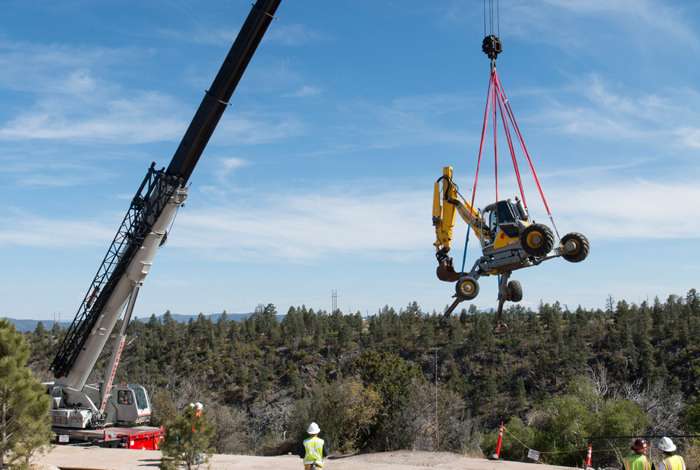Unique environmental remediation project on steep canyon successfully completed

A multi-disciplinary team recently completed a unique remediation project at Los Alamos National Laboratory (LANL) that involved removing contaminated rock and soil from a steep canyon slope that was only accessible from the parking lot of a busy shopping center.
"This is a great example of early planning, and excellent teamwork," said LANS Project Manager Todd Haagenstad. "We considered all the risks, brought in the right subject matter experts, and put the right processes in place to execute the work."
The work, which was completed under a cleanup agreement with the New Mexico Environment Department, is the result of a collaboration between the U.S. Department of Energy Environmental Management Los Alamos Field Office (DOE EM-LA), LANS and small business subcontractor TerranearPMC.
After beginning the project in early May, the field work was completed on June 15, with transfer of land access back to the property owner three weeks ahead of schedule. "In a novel approach to reach the virtually inaccessible worksite, TerranearPMC used a 275-ton, all-terrain crane to transport workers and specialized excavation equipment down to the canyon slope and to remove waste packages generated during remediation activities," said TerranearPMC Chief Executive Officer Ken Fillman.
The project, part of the larger Upper Los Alamos Canyon Aggregate Area, included the remediation and site restoration of mercury-contaminated soil from Solid Waste Management Unit (SWMU) 32-002(b2) at the former Technical Area 32, which wasa small medical research facility consisting of three laboratories, an office building, a warehouse, and a valve house. SWMU 32-002(b2) is the former outfall pipe of a septic system located on a high-angle slope south of the Smith's Marketplace parking lot on property owned by DOE. Elevated levels of mercury in soil were detected during characterization sampling. Mercury levels greater than or equal to 5mg/kg were excavated as part of this remediation effort.
Prior to the mobilization of heavy equipment, the team built two temporary access ramps and a crane pad to support crane mobilization. After the access ramps were built and approved, the team mobilized the crane, which was specifically selected because of its all-terrain capabilities and its lifting capacity and long reach. The crane's capacity allowed TerranearPMC to safely place a spider excavator onto the otherwise inaccessible excavation site.
The spider excavator is a rubber-tired four-wheel drive excavator with extendable, fully articulated control arms in conjunction with articulating stabilizers to allow it to anchor and maneuver on extreme or tight terrain. The maneuverability and safety of this machine on steep terrain allowed it to access the entire excavation area and to safely remove large boulders from the excavation site.
Approximately 158 cubic yards of mercury-contaminated soil was removed from the site down to depths ranging from 2-5 feet below grade and prepared for off-site disposal. The spider excavator was also used to load waste containers with contaminated soil, and supported final site restoration and stabilization of the excavation site. "The capability of the crane and versatility of the spider excavator were invaluable to the successful execution of this project," TerranearPMC Project Manager Pattie Baucom said. "The use of the crane and spider excavator allowed us to work in extreme terrain with difficult access while minimizing our footprint on the mesa top occupied by the shopping center."
"This was a technically complex project—both because of the high public visibility and proximity to the Smith's Marketplace shopping center in Los Alamos and the limited accessibility to the work site," Baucom said. "The TerranearPMC team developed a unique technical approach that was really a win-win all the way around and worked closely with LANS and EM-LA to implement it successfully. We were able to make worker health and safety our absolute priority, while minimizing the impact to the area around the remediation site and the nearby property owners and businesses.
TerranearPMC and LANS collaborated on health and safety plans, access agreements, and critical lift plans (required to hoist personnel and to lower and lift the spider excavator) to guide the work.
The TerranearPMC team included Envirocon, in collaboration with All Mountain Construction Spider Excavation Service and Crane Service Inc. of Albuquerque, NM. "The collaborative effort between the TPMC team, the Laboratory's Environmental Programs Division, and the DOE-EM and NNSA field offices was impressive and resulted in a flawless execution," Baucom said.
Provided by Los Alamos National Laboratory


















